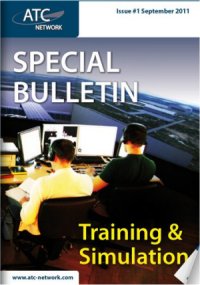
This article originally appeared in the ATC Network Special Bulletin 'Training and Simulation - September 2011. To read the complete publication go to:
http://www.atc-network.com/training
Anders Halkov-Jensen,ENTRY POINT NORTH
http://www.atc-network.com/training
Anders Halkov-Jensen,ENTRY POINT NORTH
 Can ATC simulators be used for chopping wood or brewing coffee? Maybe not, but join Training Specialist and controller Anders Halskov-Jensen from ATS Academy Entry Point North as he reflects on how to use simulators in a broader context.
Can ATC simulators be used for chopping wood or brewing coffee? Maybe not, but join Training Specialist and controller Anders Halskov-Jensen from ATS Academy Entry Point North as he reflects on how to use simulators in a broader context. ATC-simulators are used to prepare students for handling real traffic. Its all about safety in our environment, and we dont want to inflict any risk on aircraft or humans by letting inexperienced students have a go.
The traditional controller education is therefore a journey from classroom theory, through hours of simulation and ending with OJT (on job training) with live traffic in an operational unit. And there is nothing wrong with that. It works.
But how about considering using simulators for other purposes? Simulation is not only for students at ATC academies, it can be a useful tool for OJT as well as for operational controllers.
Its not always that live traffic provides the situations that students need to practise. But simulators can provide any scenario with preparation.
Maybe final OJT could be combined with simulation targeted towards specific topics i.e. spacing, speed control, holding, final line up and so on. New controllers would be able to start with broader experience while the OJT-period (and associated costs) could be reduced. Maybe even the national regulator could be convinced to let the simulation count as part of the mandatory required hours of training? The simulator experts at Entry Point North recently created a simulation airport and exercises for the specific purpose of training a student on final OJT. The reason for creating this special training for the customer was that instructors were reluctant to validate the student. But with a targeted effort in the simulator, the student gained the required skills and was validated in a month.
Maybe final OJT could be combined with simulation targeted towards specific topics i.e. spacing, speed control, holding, final line up and so on. New controllers would be able to start with broader experience while the OJT-period (and associated costs) could be reduced. Maybe even the national regulator could be convinced to let the simulation count as part of the mandatory required hours of training? The simulator experts at Entry Point North recently created a simulation airport and exercises for the specific purpose of training a student on final OJT. The reason for creating this special training for the customer was that instructors were reluctant to validate the student. But with a targeted effort in the simulator, the student gained the required skills and was validated in a month.
 Just as pilots, controllers must receive refresher training regularly. Aircraft simulators are exactly like the real thing allowing pilots to go through some very advanced training. In ATC, simulators are also used for unusual events training, but often its just a typical exercise like Control, we have a sick passenger and would like to divert to.. thrown in. Operational controllers, however, may also benefit from practising scenarios that affect their work even more. It could be exercises with reduced radar coverage or passing all estimates on phone in a no data connection-simulation or the closure of a major airport in heavy traffic etc.
Just as pilots, controllers must receive refresher training regularly. Aircraft simulators are exactly like the real thing allowing pilots to go through some very advanced training. In ATC, simulators are also used for unusual events training, but often its just a typical exercise like Control, we have a sick passenger and would like to divert to.. thrown in. Operational controllers, however, may also benefit from practising scenarios that affect their work even more. It could be exercises with reduced radar coverage or passing all estimates on phone in a no data connection-simulation or the closure of a major airport in heavy traffic etc. It can all be done in the simulator, and its worthwhile to sharpen controllers skills this way.
Think out of the box when planning refresher training. Snow removal, blocked RWYs, capacity training, ops-room evacuation, there are a lot of items that could be trained and practised in the simulator besides the common and suddenly something happens to one aircraft-scenarios.
Not all ATS-units have simulator-positions nearby or the necessary resources to develop simulator exercises beyond the required. In that case a solution might be to contact an experienced training academy where help can be obtained. At Entry Point North, we can assist in any part of training from mere simulator rental to exercise development or actual training. We have equipped a large trailer with simulator positions, enabling us to bring the simulator to i.e. small remote airports without training facilities and then give the staff refresher training on the spot.
Dont be afraid to train on a simulator with a different HMI. Its just like driving a car.
Traditionally, huge efforts have been made to make ATC simulators emulate the HMI of the operational system. The idea is to minimise the time students have to spend on learning how to operate the controller working position. But unless the HMI is mimicked 100%, controllers on supplementary training will question the small differences between their operational system and the simulator, which is often delivered by a different manufacturer than the ops-system. So dont be afraid to train on a simulator with a different HMI. Its just like driving a car. Your present car is probably not the same make and model as the one you had your driving lessons in, am I right? But as long as it has pedals and a steering wheel you can operate it, once youve noticed the location of lights, buttons etc. Same with simulators. It might actually be easier to adapt to a completely different HMI than one that only emulates the operational one 90%. Those last 10% will become a surprise and a nuisance every time, and will take focus away from the purpose of the training.
Think open minded, when considering the use of ATC simulators, regardless of whether you have your own or use a Training Academy. Check with your simulator experts if your ideas are possible. Most likely, they are.
Dont be afraid to train on a simulator with a different HMI. Its just like driving a car.
Traditionally, huge efforts have been made to make ATC simulators emulate the HMI of the operational system. The idea is to minimise the time students have to spend on learning how to operate the controller working position. But unless the HMI is mimicked 100%, controllers on supplementary training will question the small differences between their operational system and the simulator, which is often delivered by a different manufacturer than the ops-system. So dont be afraid to train on a simulator with a different HMI. Its just like driving a car. Your present car is probably not the same make and model as the one you had your driving lessons in, am I right? But as long as it has pedals and a steering wheel you can operate it, once youve noticed the location of lights, buttons etc. Same with simulators. It might actually be easier to adapt to a completely different HMI than one that only emulates the operational one 90%. Those last 10% will become a surprise and a nuisance every time, and will take focus away from the purpose of the training.
Think open minded, when considering the use of ATC simulators, regardless of whether you have your own or use a Training Academy. Check with your simulator experts if your ideas are possible. Most likely, they are.




.png)


.jpg)
